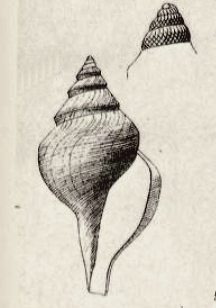Xanthodaphne leptalea
Xanthodaphne leptalea is a species of sea snail, a marine gastropod mollusk in the family Raphitomidae.[1]
| Xanthodaphne leptalea | |
|---|---|
 | |
| Original image of shell and protoconch of Xanthodaphne leptalea | |
| Scientific classification | |
| Kingdom: | Animalia |
| Phylum: | Mollusca |
| Class: | Gastropoda |
| Clade: | Caenogastropoda |
| Clade: | Hypsogastropoda |
| Clade: | Neogastropoda |
| Superfamily: | Conoidea |
| Family: | Raphitomidae |
| Genus: | Xanthodaphne |
| Species: | X. leptalea |
| Binomial name | |
| Xanthodaphne leptalea (Bush, 1893) | |
| Synonyms[1] | |
| |
Description
The length of the shell attains 24 mm.
(Original description) The shell is of moderate size, rather stout, very thin and fragile, delicately tinted with brown below the chestnut-brown tip. It consists of four obtusely shouldered whorls besides the protoconch. The aperture is long, rather broad, pinched in anteriorly, forming a moderately long, narrow siphonal canal. The outer lip is badly broken, but, judging by the lines of growth, sweeps well forward from the posterior sinus, which is as wide as the subsutural band, and deepest next the suture. The columella is very straight with a narrow, very thin, closely adhering layer of enamel. The subsutural band is broad, oblique, crossed by numerous very delicate curved riblets and lines of growth, most conspicuous just at the suture. At the angle of the shoulder just below the periphery there is, on the two upper whorls, a row of small nodules, which gradually disappear on the penultimate whorl and are entirely wanting on the body whorl. The spiral sculpture consists of narrow, shallow grooves separated by rather broad, flattened bands of nearly uniform width, which cover the entire surface except the subsutural band and protoconch. Those on the shoulder are a little closer together than elsewhere. Lines of growth are rather indistinct. The protoconch is large, consisting of four conspicuously reticulated, chestnut-brown whorls which increase in size very abruptly from the very small apical whorl. [2]
Distribution
This species occurs in the Atlantic Ocean off Morocco at a depth of 2212 m; also off North Carolina and South Carolina, USA.
References
- Xanthodaphne leptalea (Bush, 1893). Retrieved through: World Register of Marine Species on 5 April 2010.
- Bush, K. (1893). Reports on the results of dredging under the supervision of Alexander Agassiz, in the Gulf of Mexico (1877-78), in the Caribbean Sea (1878, 79), and along the Atlantic coast of the United States (1880), by the U.S. Coast Survey Steamer "Blake." Lieut.-Com. C.D. Sigsbee, U.S.N., and Commander J.R. Bartlett, U.S.N., Commanding. XXXIV. Report on the Mollusca dredged by the "Blake" in 1880, including descriptions of several new species. Bulletin of the Museum of Comparative Zoology. 23(6): 199-244, pl. 1-2
- Sysoev A.V. (2014). Deep-sea fauna of European seas: An annotated species check-list of benthic invertebrates living deeper than 2000 m in the seas bordering Europe. Gastropoda. Invertebrate Zoology. Vol.11. No.1: 134–155
- Gofas, S.; Le Renard, J.; Bouchet, P. (2001). Mollusca. in: Costello, M.J. et al. (eds), European Register of Marine Species: a check-list of the marine species in Europe and a bibliography of guides to their identification. Patrimoines Naturels. 50: 180-213.
External links
- Locard, A., 1897 Mollusques testacés. In: Expéditions scientifiques du Travailleur et du Talisman pendant les années 1880, 1881, 1882, 1883, vol. 1, p. 516 p, 22 pls
- MNHN, Paris: specimen
- MNHN, Paris: holotype
- Tucker, J.K. (2004). "Catalog of recent and fossil turrids (Mollusca: Gastropoda)" (PDF). Zootaxa. 682: 1–1295.